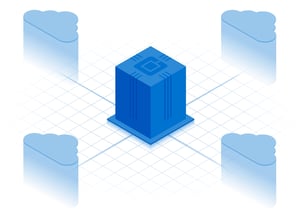Peering Exchanges
Options for Fast, Effective Connection with Hundreds of Networks
Power Business Growth with a “Network of Networks”
Peering refers to an exchange of data traffic between independent networks for the benefit of both parties. Peering exchanges, or internet exchanges (IXs), are network access points at which collaborating companies connect their networks to exchange data.
The Any2Exchange® provides internet peering, and CoreSite offers connectivity to top global internet exchanges such as AMS-IX, DE-CIX, LINX, NYIIX, United IX and BBIX. CoreSite's regional exchanges on the East and West Coasts enable participants from multiple markets to seamlessly peer through our data centers.

Increase Redundancy and Improve Application Performance
Reduce Latency, Increase Resilience and Security
Extend reach and improve access to partners and content with elevated network performance.
Peering creates direct data flows with fewer network hops, eliminating network bottlenecks that can slow business transactions and degrade user experiences. Peering also increases the number of available network paths, which improves capacity planning, efficiency and fault tolerance. Network diversity helps to maintain service quality – and a bonus is reduced transit costs.
Peering exchanges lower risk. Using the public internet carries well-known risks. Data can be intercepted or corrupted. Sensitive information is more vulnerable to cyber threats. Outdated internet protocols are another concern. In contrast, peering over internet exchanges (like CoreSite’s Any2Exchange) enables sharing data over highly secure routes.
With the public internet, data travels via unpredictable and potentially congested paths. In peering through a CoreSite data center, a Border Gateway Protocol (BGP) acts like a traffic cop, making routing decisions based on the shortest path. And, with CoreSite, you don’t need to set up and maintain multiple BGP sessions that are time-consuming to manage.
Keep Local Traffic Local, Lower Latency and Reduce Traffic Costs
The Mechanism of Peering
Moving data from point a to point z requires an interconnection mechanism between two networks (direct) or three or more networks (indirect). Network providers, telecom companies, content delivery networks, internet service providers (ISPs), cloud service providers and other enterprises negotiate agreements related to data handoffs and routes – generally no costs are involved.
.png?width=300&name=IMAGE%20(1).png)










